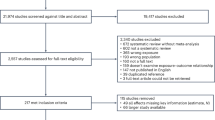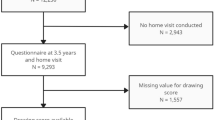Abstract
BACKGROUND
Screen-based media use is prevalent in children and is associated with health risks. American Academy of Pediatrics (AAP) recommendations involve access to screens, frequency, content, and co-viewing. The aim of this study was to test the ScreenQ, a composite measure of screen-based media use.
METHODS
ScreenQ is a 15-item parent report measure reflecting AAP recommendations. Range is 0–26, higher scores reflecting greater non-adherence. With no “gold standard” available, four validated measures of skills and parenting practices cited as influenced by overuse were applied as the external criteria, including expressive language, speed of processing, emergent literacy, and cognitive stimulation at home. Psychometric analyses involved Rasch methods and Spearman’s ρ correlations.
RESULTS
Sixty-nine families were administered ScreenQ. Child age ranged from 36 to 63 months old (52 ± 8; 35 girls). Mean ScreenQ score was 9.6 (±5.0; 1–22). Psychometric properties were strong (rCo-α = 0.74). ScreenQ scores were negatively correlated with CTOPP-2 (Comprehensive Test of Phonological Processing, Second Edition) (rρ = −0.57), EVT-2 (Expressive Vocabulary Test, Second Edition) (rρ = −0.45), GRTR (Get Ready to Read!) (rρ = −0.30) and StimQ-P (rρ = −0.42) scores (all p ≤ 0.01).
CONCLUSIONS
ScreenQ shows potential as a composite measure of screen-based media use in young children in the context of AAP recommendations. ScreenQ scores were correlated with lower executive, language and literacy skills, and less stimulating home cognitive environment.
Similar content being viewed by others
Log in or create a free account to read this content
Gain free access to this article, as well as selected content from this journal and more on nature.com
or
References
Rideout, V. The Common Sense Census: Media Use by Kids Age Zero to Eight (Common Sense Media, San Francisco, 2017).
Carter, B., Rees, P., Hale, L., Bhattacharjee, D. & Paradkar M. S. Association between portable screen-based media device access or use and sleep outcomes: a systematic review and meta-analysis. JAMA Pediatr. 170, 1202–1208 (2016).
AAP Council on Communications and Media. Media and Young Minds. Pediatrics (American Academy of Pediatrics, Elk Grove, 2016).
Robinson, T. N. et al. Screen media exposure and obesity in children and adolescents. Pediatrics 140, S97–S101 (2017).
Anderson, D. R. & Subrahmanyam, K. Digital screen media and cognitive development. Pediatrics 140, S57–S61 (2017).
Garrison, M. M., Liekweg, K. & Christakis, D. A. Media use and child sleep: the impact of content, timing, and environment. Pediatrics 128, 29–35 (2011).
Lillard, A. S., Li, H. & Boguszewski, K. Television and children’s executive function. Adv. Child Dev. Behav. 48, 219–248 (2015).
Walsh, J. J. et al. Associations between 24 h movement behaviours and global cognition in US children: a cross-sectional observational study. Lancet Child Adolesc. Health 2, 783–791 (2018).
Choi, J. H. et al. Real-world usage of educational media does not promote parent–child cognitive stimulation activities. Acad. Pediatr. 18, 172–178 (2018).
Tomopoulos, S. et al. Is exposure to media intended for preschool children associated with less parent-child shared reading aloud and teaching activities? Ambul. Pediatr. 7, 18–24 (2007).
Mendelsohn, A. L. et al. Infant television and video exposure associated with limited parent-child verbal interactions in low socioeconomic status households. Arch. Pediatr. Adolesc. Med. 162, 411–417 (2008).
Paulus, M. P. et al. Screen media activity and brain structure in youth: evidence for diverse structural correlation networks from the ABCD study. Neuroimage 185, 140–153 (2019).
Hutton, J. S., Dudley, J., Horowitz-Kraus, T., DeWitt, T. & Holland, S. K. Differences in functional brain network connectivity during stories presented in audio, illustrated, and animated format in preschool-age children. Brain Imaging Behav. 14, 130–141 (2020).
Horowitz-Kraus, T. & Hutton, J. S. Brain connectivity in children is increased by the time they spend reading books and decreased by the length of exposure to screen-based media. Acta Paediatr. 107, 685–693 (2018).
Bryant, M. J., Lucove, J. C., Evenson, K. R. & Marshall, S. Measurement of television viewing in children and adolescents: a systematic review. Obes. Rev. 8, 197–209 (2007).
Magee, C. A., Lee, J. K. & Vella, S. A. Bidirectional relationships between sleep duration and screen time in early childhood. JAMA Pediatr. 168, 465–470 (2014).
Nightingale, C. M. et al. Screen time is associated with adiposity and insulin resistance in children. Arch. Dis. Child 102, 612–616 (2017).
Hutton, J. S., Xu, Y., DeWitt, T. & Ittenbach, R. F. Assessment of Screen-Based Media Use in Children: Development and Psychometric Refinement of the ScreenQ Pediatric Academic Societies Meeting (Toronto, Canada, 2018).
Phillips, B. M., Lonigan, C. J. & Wyatt, M. A. Predictive validity of the get ready to read! Screener: concurrent and long-term relations with reading-related skills. J. Learn Disabil. 42, 133–147 (2009).
Bellevue Project for Early Language Literacy and Education Success (BELLE). STIMQ Home Cognitive Environment (Bellevue Project for Early Language, Literacy, and Education Success (BELLE), New York University School of Medicine, Department of Developmental and Behavioral Pediatrics, 2018).
Harris, P. et al. Research electronic data capture (REDCap)—a metadata-driven methodology and workflow process for providing translational research informatics support. J. Biomed. Inf. 42, 377–381 (2009).
Williams, K. T. Expressive Vocabulary Test 2nd edn (EVT-2) (Pearson Assessments, Minneapolis, 2007).
Wagner, R. K., Torgesen, J. K., Rashotte, C. A. & Pearson, N. A. CTOPP-2: Comprehensive Test of Phonological Processing–Second Edition (Pro-Ed, Austin, 2019).
Smith, E. V. & Smith, R. M. Rasch Measurement: Advanced and Specialized Applications (JAM Press, Maple Grove, 2007).
Smith, R. M. Detecting item bias with the Rasch model. J. Appl Meas. 5, 430–449 (2004).
Early Childhood Teacher. ECE Technology: 10 Trending Tools for Teachers (EarlyChildhoodTeacher.org, Washington, 2019).
Pagani, L. S., Harbec, M. J. & Barnett, T. A. Prospective associations between television in the preschool bedroom and later bio-psycho-social risks. Pediatr. Res. 85, 967–973 (2019).
Duggan, M. P., Taveras, E. M., Gerber, M. W., Horan, C. M. & Oreskovic, N. M. Presence of small screens in bedrooms is associated with shorter sleep duration and later bedtimes in children with obesity. Acad Pediatr. 19, 515–519 (2019).
Domoff, S. E., Lumeng, J. C., Kaciroti, N. & Miller, A. L. Early childhood risk factors for mealtime TV exposure and engagement in low-income families. Acad. Pediatr. 17, 411–415 (2017).
Hamilton, K., Spinks, T., White, K. M., Kavanagh, D. J. & Walsh, A. M. A psychosocial analysis of parents’ decisions for limiting their young child’s screen time: an examination of attitudes, social norms and roles, and control perceptions. Br. J. Health Psychol. 21, 285–301 (2016).
Ma, J. & Birken, C. Handheld Screen Time Linked with Speech Delays in Young Children (Pediatric Academic Societies Meeting, San Francisco, 2017).
McNeill, J., Howard, S. J., Vella, S. A. & Cliff D. P. Longitudinal associations of electronic application use and media program viewing with cognitive and psychosocial development in preschoolers. Acad Pediatr. 19, 520–528 (2019).
Radesky, J. S. & Christakis, D. A. Increased screen time: implications for early childhood development and behavior. Pediatr. Clin. N. Am. 63, 827–839 (2016).
Yuill, N. & Martin, A. F. Curling up with a good E-Book: mother–child shared story reading on screen or paper affects embodied interaction and warmth. Front. Psychol. 7, 1951 (2016).
Chiong, C., Ree, J. & Takeuchi, L. Comparing Parent–Child Co-reading on Print, Basic, and Enhanced e-Book Platforms (The Joan Ganz Cooney Center at Sesame Workshop, New York, 2012).
Ribner, A., Fitzpatrick, C. & Blair, C. Family socioeconomic status moderates associations between television viewing and school readiness skills. J. Dev. Behav. Pediatr. 38, 233–239 (2017).
Bentley, G. F., Turner, K. M. & Jago, R. Mothers’ views of their preschool child’s screen-viewing behaviour: a qualitative study. BMC Public Health 16, 718 (2016).
Peterson, R. A. A meta-analysis of Cronbach’s coefficient alpha. J. Consumer Res. 21, 381–391 (1994).
Acknowledgements
We would like to thank research coordinators Arielle Wilson and Amy Kerr for overseeing data collection, data entry, and quality control. We also acknowledge Dr. Alan Mendelsohn, M.D. and his team at the Bellevue Project for Early Language, Literacy, and Education Success (BELLE Project) for the development of the StimQ measure, which provided inspiration for the ScreenQ name, and for their generosity sharing StimQ for the benefit of children and families. This study was funded by a Procter Scholar Award from the Cincinnati Children’s Research Foundation (Hutton).
Author information
Authors and Affiliations
Contributions
J.S.H. researched and drafted the ScreenQ screening instrument used in this study, designed the study protocol, supervised data collection, collaborated in data analysis and measure refinement, and drafted the initial manuscript and subsequent revisions. G.H. and R.D.S. performed all data analysis for this study, created the tables and graphs, and reviewed and revised the manuscript and subsequent revisions. T.D.W. provided guidance on the study protocol design, analysis, and measure refinement, and reviewed and revised the manuscript. R.I. directed and supervised psychometric and other data analyses, consulted in the development and refinement of ScreenQ screening instrument, reviewed and revised the manuscript, and approved the final manuscript as submitted.
Corresponding author
Ethics declarations
Competing interests
The authors declare no competing interests.
Additional information
Publisher’s note Springer Nature remains neutral with regard to jurisdictional claims in published maps and institutional affiliations.
Supplementary information
Rights and permissions
About this article
Cite this article
Hutton, J.S., Huang, G., Sahay, R.D. et al. A novel, composite measure of screen-based media use in young children (ScreenQ) and associations with parenting practices and cognitive abilities. Pediatr Res 87, 1211–1218 (2020). https://doi.org/10.1038/s41390-020-0765-1
Received:
Revised:
Accepted:
Published:
Issue date:
DOI: https://doi.org/10.1038/s41390-020-0765-1
This article is cited by
-
The Impact of Modifiable Parenting Factors on the Screen Use of Children Five Years or Younger: A Systematic Review
Clinical Child and Family Psychology Review (2025)
-
Parental executive functions and motivations unveil variations in young children's screen media use
Psicologia: Reflexão e Crítica (2024)
-
A study of the effects of screen exposure on the neuropsychological development in children with autism spectrum disorders based on ScreenQ
BMC Pediatrics (2024)
-
Parental beliefs and mediation co-mediate the SES effect on chinese preschoolers’ early digital literacy: A chain-mediation model
Education and Information Technologies (2024)
-
Young children’s screen time during the first COVID-19 lockdown in 12 countries
Scientific Reports (2022)



